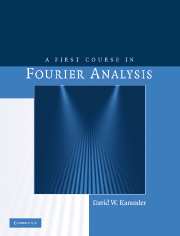Book contents
- Frontmatter
- Contents
- Preface
- 1 Fourier's representation for functions on, Tp, and ℙN
- 2 Convolution of functions on, Tp, and ℙN
- 3 The calculus for finding Fourier transforms of functions on ℝ
- 4 The calculus for finding Fourier transforms of functions on Tp, and ℙN
- 5 Operator identities associated with Fourier analysis
- 6 The fast Fourier transform
- 7 Generalized functions on ℝ
- 8 Sampling
- 9 Partial differential equations
- 10 Wavelets
- 11 Musical tones
- 12 Probability
- Appendices
- Index
10 - Wavelets
Published online by Cambridge University Press: 01 September 2010
- Frontmatter
- Contents
- Preface
- 1 Fourier's representation for functions on, Tp, and ℙN
- 2 Convolution of functions on, Tp, and ℙN
- 3 The calculus for finding Fourier transforms of functions on ℝ
- 4 The calculus for finding Fourier transforms of functions on Tp, and ℙN
- 5 Operator identities associated with Fourier analysis
- 6 The fast Fourier transform
- 7 Generalized functions on ℝ
- 8 Sampling
- 9 Partial differential equations
- 10 Wavelets
- 11 Musical tones
- 12 Probability
- Appendices
- Index
Summary
The Haar wavelets
Introduction
We use dilates of the complex exponential wave
w(x) ≔ e2πix, -∈ < x < ∈
when we write the familiar Fourier synthesis equation
for a suitably regular function f on ℝ. (The function F is the Fourier transform of f.) For example, the identity
shows how to synthesize a normal density by combining waves of constant amplitude,
which stretch from x = -∞ to x = +∞. When 0 < σ ≪ 1, this density is an approximate delta with 99.7% of its integral in the tiny interval -3σ ≤ x ≤ 3σ. Almost perfect destructive interference must occur at every point |x| > 3σ. Such a synthesis has mathematical validity (a proof is given in Section 1.5), but it is physically unrealistic. In practice, we cannot produce the audio signal for a 1-ms “click” by having tubas, trombones, …, piccolos play sinusoidal tones of constant amplitude for all eternity!
In this chapter you will learn to synthesize a function f with localized, oscillatory basis functions called wavelets. We use the prototype Haar wavelet
to introduce the fundamental concepts from an exciting new branch of analysis created by mathematicians, electrical engineers, physicists, … during the last two decades of the 20th century. More sophisticated wavelets for audio signal processing, image compression, etc. are described in the following sections.
You will observe that the wavelet (1) oscillates. The positive and negative parts of ψ have the same size in the sense that
It is easy to produce a function y on R that interpolates f at the sample points, i.e., …
Information
- Type
- Chapter
- Information
- A First Course in Fourier Analysis , pp. 593 - 692Publisher: Cambridge University PressPrint publication year: 2008
